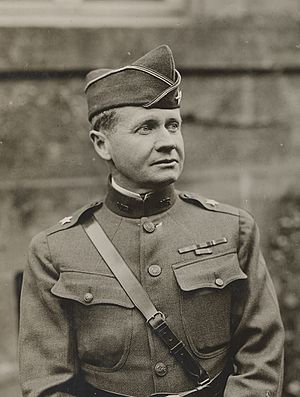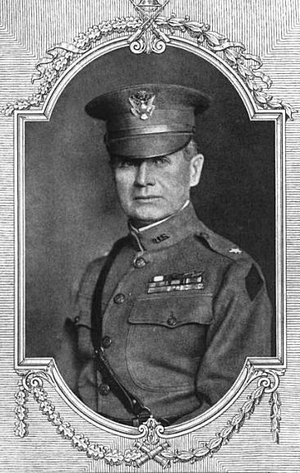Paul Bernard Malone facts for kids
Quick facts for kids
Paul Bernard Malone
|
|
|---|---|

Brigadier general Paul Malone, commanding general 10th brigade, 5th division, Longuyon, November 1918
|
|
| Nickname(s) | Follow Me! |
| Born | May 8, 1872 Middletown, New York |
| Died | October 16, 1960 (aged 88) Sarasota, Florida |
| Allegiance | |
| Service/ |
|
| Years of service | 1894–1936 |
| Rank | |
| Unit | |
| Commands held | Fourth United States Army Ninth Corps Area Third Corps Area Sixth Corps Area Philippine Division 2nd Infantry Division 10th Brigade, 5th Infantry Division 23rd Infantry Regiment |
| Battles/wars | Spanish–American War
Philippine–American War
|
| Awards | Distinguished Service Cross Distinguished Service Medal Silver Star Croix de Guerre Legion of Honour |
| Other work | writer |
Paul Bernard Malone (May 8, 1872 – October 16, 1960) was a brave and highly honored officer in the United States Army. He reached the rank of major general. After graduating from the United States Military Academy, he fought in the Spanish–American War and the Philippine–American War.
During World War I, Malone led an Infantry Brigade. He became a Brigadier General and showed great courage during the Battle of Soissons. He received many awards, including the Distinguished Service Cross and the Distinguished Service Medal. He also earned several awards from other countries. Malone continued to serve in the Army after the war, retiring in 1936.
Contents
Early Life and Military Beginnings
Paul B. Malone was born on May 8, 1872, in Middletown, New York. His parents were Irish immigrants. Paul went to Saint James Parochial School and the De La Salle Institute.
In 1890, he was accepted into the United States Military Academy in West Point, New York. He graduated four years later with a science degree. Many of his classmates also became generals later on.
First Assignments and Early Wars
After graduating, Malone became a second lieutenant in the Infantry branch. He joined the 13th Infantry Regiment in New York. In 1898, he was promoted to first lieutenant and sailed to Cuba.
He showed great bravery during the Battle of San Juan Hill in the Spanish–American War. For his actions, he received the Silver Star award.
Service in the Philippines and Teaching
In 1901, Malone moved to the Philippines to join the 27th Infantry Regiment. He helped chase a rebel leader named Emilio Aguinaldo. After this, he returned to the United States.
He was promoted to Captain in November 1901. He then became a Chemistry instructor at the United States Military Academy. One of his students was Douglas MacArthur, who later became a famous general.
Malone taught for five years. Then, he went back to Cuba for a special duty. He worked as a Judge Advocate and Provost Marshal General for two years.
Advanced Training and International Experience
After Cuba, Malone attended the Army School of the Line in Fort Leavenworth, Kansas. He graduated with honors in 1909. He then studied at the Army Staff College in Washington, D.C..
He was assigned to the War Department General Staff. In 1912, Malone and two other captains visited Germany. They observed the German Imperial Army's training exercises.
In 1913, Malone moved to Honolulu, Hawaiian Islands. He served with the 2nd Infantry Regiment. In 1916, he was promoted to Major. He became Chief of Staff for the Eagle Pass District in Texas. He served on the Mexican Border during the Pancho Villa Expedition.
World War I Service
When the United States entered World War I, Malone was promoted to Lieutenant Colonel. He traveled to France in June 1917. He worked at the General Headquarters for the American Expeditionary Forces (AEF). He helped plan and train all AEF forces.
Leading the 23rd Infantry Regiment
In February 1918, Malone became a Colonel. He took command of the 23rd Infantry Regiment. This unit was part of the 2nd Infantry Division. They trained and then entered combat in the Sommedieue area.
During the Battle of Belleau Wood in June 1918, Malone's regiment was in reserve. But they were quickly called to fill a gap in the battle lines.
Heroism at Soissons
Malone led his regiment in the Battle of Soissons on July 19, 1918. He showed great bravery. Even under heavy enemy fire, he often visited his troops at the front lines.
On July 18, after his regiment had many losses, he helped reorganize a battalion for an attack. The next morning, he personally checked the front lines to find the enemy's position. This information was very important. Malone then led his regiment to attack and defeat the German forces. For his courage at Soissons, he received the Distinguished Service Cross. This is the second highest award for bravery in the U.S. Armed Forces.
Commanding the 10th Infantry Brigade
In August 1918, Malone was put in charge of the 10th Infantry Brigade. This brigade was part of the 5th Division. They fought in the Battle of Saint-Mihiel, advancing almost eight kilometers.
He was promoted to Brigadier General on October 1, 1918. During the Meuse-Argonne Offensive, Malone's brigade captured important areas. They crossed the Meuse river and cleared the eastern heights. They took several villages and advanced eighteen kilometers before the war ended.
For his leadership, Malone received the Army Distinguished Service Medal. He also received two high French awards: the Legion of Honour, rank Officer and the Croix de Guerre 1914-1918 with Palm.
Later Army Career
After World War I, Malone returned to the United States. He became a Lieutenant Colonel again. He worked at the War Department General Staff. Then, he went to the Army Infantry School at Fort Benning.
He served as Assistant Commandant there. During this time, he became a Colonel. He is also known for designing the school's crest, which has the motto "Follow Me!".
Promotions and Commands
In April 1925, Malone was promoted to Brigadier General again. He took command of the 2nd Infantry Division in Fort Sam Houston, Texas. He supported a fund for war orphans. He even gave a speech from an airplane 3,000 feet in the air, which was a first for radio.
He briefly commanded the 12th Infantry Brigade in Illinois. In March 1928, he was promoted to Major General. He then commanded the Sixth Corps Area in Chicago.
In 1929, Malone went to the Philippines. He commanded the Philippine Division. He worked under Major General Douglas MacArthur.
Final Years in Service
Malone returned to the U.S. in 1931. He commanded the Third Corps Area in Baltimore, Maryland. In 1935, he moved to San Francisco. He took command of the Ninth Corps Area. His units participated in the California Pacific International Exposition.
In May 1935, he also became Commanding General of the Fourth United States Army. This army planned defenses for the Pacific Coast and western U.S. Malone retired on April 30, 1936, after 42 years of service.
Life After the Army
After retiring, Malone lived in San Francisco, California. He worked as an administrator for the State Brewers’ Institute. He was also active in the American Legion, a group for war veterans.
World War II Efforts
During World War II, Malone's military skills were needed again. In 1942, he was considered for a defense coordinator role in Marin County, California. However, he was not appointed due to internal issues.
Malone then led the "Minute Men of '42" in Madera County, California. This group trained hunters and gun owners. They prepared for armed resistance in case of invasion or sabotage. The organization was set up like a military unit.
He also served on the State Guard committee. He suggested increasing the guard's strength. In 1942, he gave a radio tribute to his former student, General Douglas MacArthur. MacArthur was fighting the Japanese in the Philippines. Malone also became a well-known military expert. He often spoke at business meetings.
Death and Legacy
Malone moved to Sarasota, Florida after World War II. He passed away there on October 16, 1960, at age 88. He was buried with full military honors at Arlington National Cemetery in Virginia. His wife, Gertrude Kerwin, is buried with him. They had four children: two daughters and two sons. Both of their sons also became Army Colonels.
Malone also wrote novels about the United States Military Academy at West Point.
In the late 1970s, several shooting ranges at the United States Army Infantry Center in Fort Benning, Georgia were named after him.
Awards and Decorations
Here are Major General Malone's awards:
| 1st Row | Distinguished Service Cross | Army Distinguished Service Medal | ||||||||||||||
|---|---|---|---|---|---|---|---|---|---|---|---|---|---|---|---|---|
| 2nd Row | Silver Star | Spanish Campaign Medal | Philippine Campaign Medal | Army Cuban Pacification Medal | ||||||||||||
| 3rd Row | Mexican Border Service Medal | World War I Victory Medal with five Battle Clasps | Legion of Honour, rank Officer | French Croix de guerre 1914–1918 with Palm | ||||||||||||


